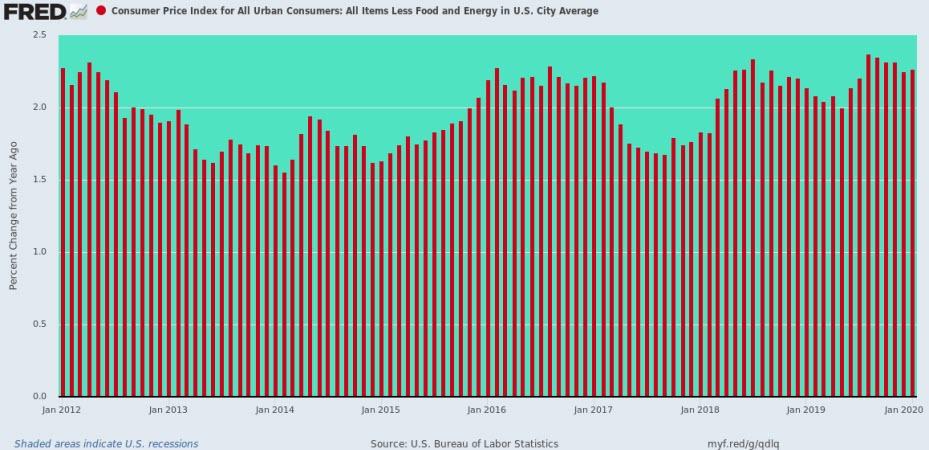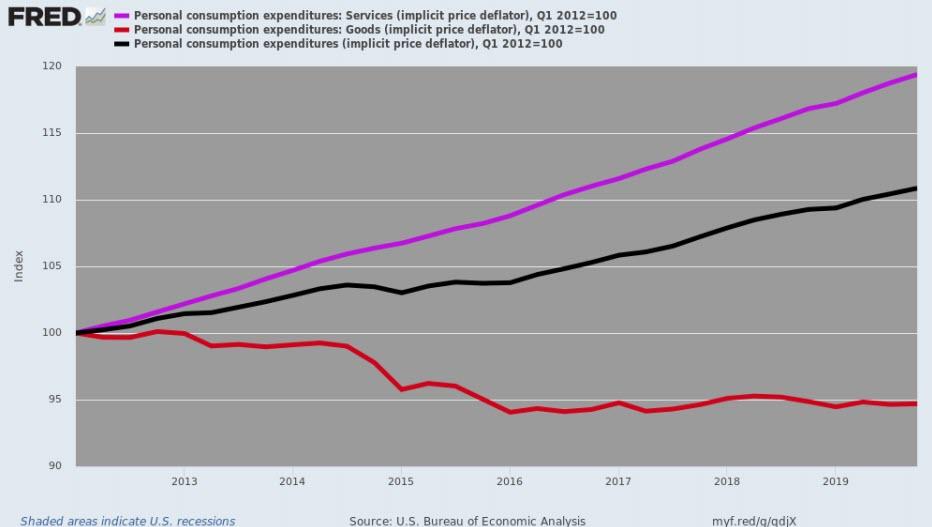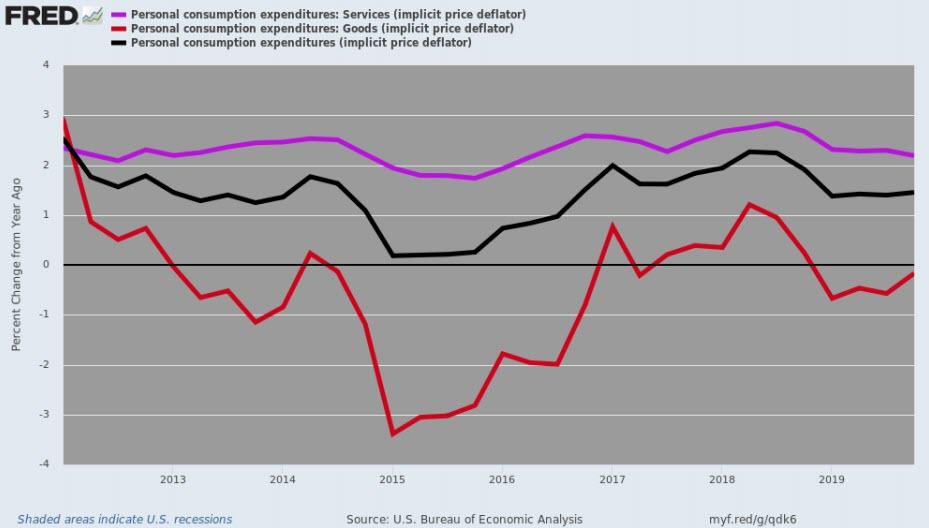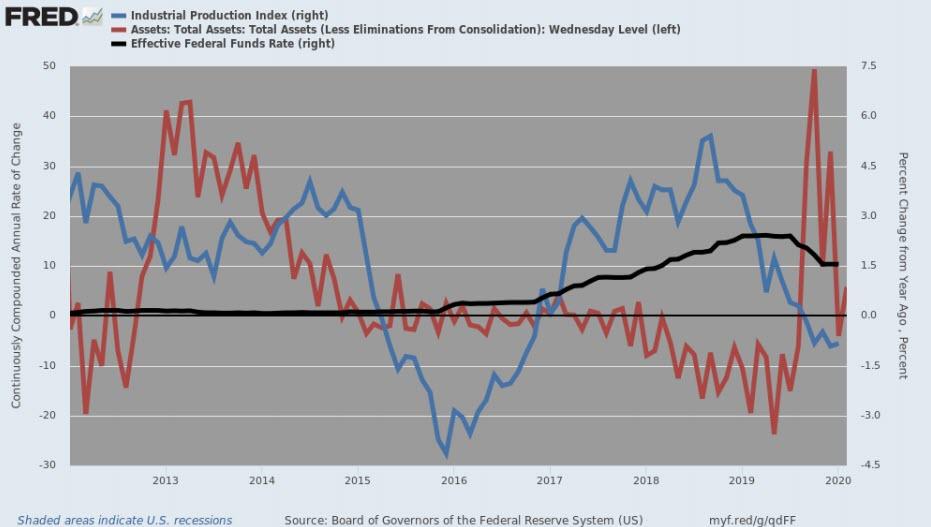...the predicate of central bank omnipotence should now be swept into
the dustpan of history.
 Authored by David Stockman: Let it be said that historians will surely marvel - and at some point soon - about the grand delusion of the present era. Namely, the near universal belief that central bankers could print, peg and palaver the main street economy into unfailing expansion and ever rising prosperity and that there were essentially no macro-risks to soaring stock prices that their toolkits couldn’t contain and counteract.
Authored by David Stockman: Let it be said that historians will surely marvel - and at some point soon - about the grand delusion of the present era. Namely, the near universal belief that central bankers could print, peg and palaver the main street economy into unfailing expansion and ever rising prosperity and that there were essentially no macro-risks to soaring stock prices that their toolkits couldn’t contain and counteract. That misbegotten belief had huge untoward consequences. It made economies brittle with too much leverage, financialization and speculation; and fragile with too few shock absorbers and insurance mechanism such as just-in-case inventories, second suppliers and local sources for physical production and back-up liquidity lines and balance sheet reserves for financial operations.
Then came the Black Bat of 2020 (or whatever) with its toxic economic contagion. Racing with virtually lightening speed through an infinitely complex and deeply integrated global supply chain anchored in the Red Ponzi, the breakdown of economic activity is already proving that the central banks are not omnipotent after all. Just as they cannot print antibodies to stop the coronavirus disease, they can’t print raw materials, intermediates, components and sub-assembly to restart broken supply chains. Super-QE wouldn’t do it; double digit subzero rates wouldn’t help; and openmouth forward guidance would only call to mind King Canute shouting at the incoming sea.
It is too early to tell, of course, as to whether the Covid-19 is the Big Bang or if it will be soon wrestled to ground by public health authorities around the planet, thereby eventually relieving the global supply chains of quarantined workers, grounded planes, ships and trains, depleted inventories and paralyzed business decision processes.
But even assuming the latter, the predicate of central bank omnipotence should now be swept into the dustpan of history. Not only can the Fed not repair and revive disrupted supply chains, but it can’t even accomplish the conventional tasks it has defined for itself. Namely, making domestic inflation rise by 2.00% annually and causing output growth to adhere unfailingly to the path of full-employment GDP, world without end.
That’s because in a world of Peak Debt—-$255 trillion globally and $74 trillion in the U.S. alone—the Fed’s policy tools are not only impotent; they are actually malignant.
It is now more than evident that the impact of massive bond-buying/balance sheet expansion (QE) and brutal repression of money market interest rates never goes beyond the canyons of Wall Street. It just inflates, inflates and inflates further the price of financial assets owing to the symbiotic confluence of carry trade speculators on Wall Street and the huge financial engineering joints that have been fostered in the C-suites of corporate America by central bankers.
As a consequence, capital has been artificially drafted into financial speculation and money dealing. At the same time, household and business balance sheets have been deeply impaired in order to live high on the hog today rather than investing for the long haul and positioning to weather the unpredictable vicissitudes of individual and collective life–illness, accidents, wars, pestilence, droughts and plagues, one of which we are now experiencing.
But virtually none of that vaunted “stimulus” makes its way to main street. Neither output, employment nor inflation is materially impacted by the Fed’s incessant interventions and machinations in the financial markets.
Take the objective of 2.00% inflation targeting that Fed head Lael Brainard was yapping about last week. In the first place we wonder exactly why she’s complaining about persistent inflation shortfalls from target and therefore the need for even more “monetary accommodation” in order to cause inflation to run hotter until it averages 2.00% over a permanent time frame.
The fact is, the CPI less its volatile food and energy components has exceeded 2.00% for 23 months running. How is that a shortfall?
Indeed, we don’t need a magnifying glass to grasp the story in this case. There is nary a single bar below the sacred 2.00% line in the entire 23 month-long chart below.
CPI Less Food And Energy, Year-Over-Year Change Since March 2018
Of course, the Fed has a different inflation measuring stick called the PCE deflator that reads lower per the discussion below. But until the Fed formally adopted inflation targeting in January 2012 based on the PCE deflator, the CPI less food and energy was seen as a serviceable proxy for the trend inflation rate shorn of the temporary volatilities attributed to global food and energy cycles.
Indeed, the low-flation crowd at the Fed and among its megaphones on Wall Street have some serious ‘splain’ to do based on the above. That’s because their argument for 2.00% inflation is that low inflation invites deflation, which, in turn, encourages consumers to defer spending in anticipation of even lower future prices, thereby impairing the spending mainspring of the Keynesian economy.
That’s complete nonsense, of course, least the plummeting price of smart phones would have queried Apple’s $1.4 trillion market cap long ago.
Still, even the Keynesian central bankers have not argued that falling food and energy prices will cause consumers to eat less or to drive fewer miles or freeze in the dark in their homes waiting for fuel prices to stop falling!
Q.E.D. If there is a low-flation problem on the entirety of the CPI which isn’t food and energy, where is it?
And we are not just talking about the last 23 months. Here is the entire span since inflation targeting was adopted. During the 97 month period from January 2012, the CPI less food and energy posted above 2.00% on a year-over-year basis more than half the time, while the average rate at 1.95% per annum was actually check-by-jowl with the target.
So if Brainard really wants multi-year averaging at 2.00%, well, we already have it.
That is, unless they actually want to argue that the 5 basis point per year average miss over nearly a decade is more than a rounding error. That’s preposterous, so it’s also case closed on the low-flation canard.
CPI Less Food And Energy, Year-Over-Year % Change Since January 2012

But there is a larger point implicit in the above. What actual direct control does the Fed have over globally driven commodity prices, as well as their second cousins, manufactured goods, the prices of which are overwhelmingly driven by global markets?
In fact, a disaggregation of the Fed’s owned ballyhooed PCE deflator puts a stake right through the low-flation argument. To wit, during the period since January 2012:
- The PCE deflator for services (purple line) is up by 19.4% or 2.31% per annum;
- The PCE deflator for goods (red line) is down by -5.3% or -0.70% per annum;
- The overall PCE deflator (black line), therefore, has risen by just 1.34% per annum because it is being pull down by global prices for goods—even as the more domestically driven prices for services have persistently exceeded the 2.00% target.
The level of disingenuous mendacity among Brainard, Powell and the rest of the “moaaaar inflation” gummers could not be more obvious than in the two charts below.
Of course, Brainard & Co. know that the purple line (domestic services) has been marching steadily higher while the red line (globally traded goods) has moved materially lower since the inflation targeting experiment was begun in 2012.
Isn’t it time, therefore, for them to admit they don’t have a snowball’s chance in the hot place of calling the tune on global oil prices or labor intensive manufactures, and therefore they need to give up on what is essentially a stupid project in the first place (inflation does not cause prosperity!).
Or if they must persist with inflation-targeting for reasons of institutional face-saving— then refocus on domestic services (not withstanding the growing impact of the “India Price” for services) and declare victory!
PCE Deflators For Goods, Service and Total Since January 2012

In fact, if you look more closely at the purple line (domestic services) expressed as a year-over-year rate of change, the low-flation lie is there for all to see. For the last eight years it has persistently posted above the 2.00% policy target line.
Also, quite obviously, the total PCE deflator (black line), which is, apparently, the Eccles Building’s holy grail, has fallen short of target because it has been powerfully pulled down from below owing to the worldwide excess of cheap industrial and transportation capital and abundant cheap labor that has been drained from the rice paddies and subsistence villages of Asia.
Not even King Canute would have attempted to roll back that mighty tide, which is exactly what 2.00% inflation targeting on the total PCE deflator amounts to.
Year-Over-Year PCE Deflator Change For Goods, Services And Total Since January 2012

As it happens, the Fed’s impotence with respect to its inflation target is also true on the output and employment front. On that score, it is constantly fine-tuning its money market repression tools (25 bps at a time) and recalibrating its QE bond purchases (and short-lived QT bonds sales).
But exactly why? After all, the extended unfolding of a long but weak-kneed business cycle expansion driven by the inherent tendency of capitalists and workers to want more and produce more has now proven the Fed doesn’t have anything to do with it.
As a theoretical and process matter, households were tapped out collectively at Peak Debt 11 years ago on the eve of the financial crisis and business have been sucked into financial engineering speculations.
This means that the traditional transmission channel from the money, debt and capital markets to main street is completely broken. “Stimulus” never gets to the latter, and, instead, remains sequestered in Wall Street were it functions to finance speculation and drive risk asset prices ever higher.
Moreover, as an empirical matter, where’s the beef?

The blue line represents total industrial production (manufacturing, construction and energy/mining). Since January 2012 it has swung substantially—-from +4.5% annual change to -4.5% annual change. But that substantial oscillation bears no relationship to the doings of Fed policy during this period.
The red line represents quantitative easing (QE) and the year-over year rate of change in the Fed balance sheet. During this eight year period it swung from positive 40% at the peak of QE in 2013 to negative -20% in 2019 during the short-lived QT episode to + 50% during last falls’ repo ruction and the subsequent return to madcap liquidity pumping.
Is there any discernible relationship between the red line and the oscillations of the industrial production index (blue line), which, in turn, drives the less severe stop and go movements of the GDP?
There is not.
The same is true of the traditional policy tool of pegging the Federal funds rate (black line). If they industrial production index could speak, it would say I never knew ya.
In sum, the economy grows owing to the rudiments of capitalism—workers, entrepreneurs, investors, inventors and savers— putting their collective shoulders to the grindstone of production and investment. It heads from the lower left to the upper right–even as it is deflected and oscillated by the rumbling forces of the global economy, and is held back by the fiscal and regulatory barriers thrown in its path by the agencies of the state.
Compared to these elemental forces, the central bankers are strictly bit players, if that.
And that gets us to the great irony of a day when the casino plunged by 1030 Dow Points because the predicate of central bank omnipotence is facing a sudden and unexpected challenge from the growing impact of Covid-19 on the global economy and its vast and intricate supply chains.
The Fed pretends it is entirely about the business of boosting main street and the employment, production, income and inflation metrics by which is performance is measured. Yet as Covid-19 now reminds, it is actually impotent on all that it sanctimoniously claims to be sheparding and enhancing.
At the same time, it claims to be focused on the stock market, if at all, only out of a squinting corner of its collective eye.
Nonsense!
All that it does is conditioned and encapsulated by wealth effects theory and a sniveling fear of a Wall Street hissy fits. So it keeps on temporizing, capitulating and re-fueling the bubbles that it dare not allow to correct.
Its true ignominy, however, is becoming ever more apparent. It has impaired main street badly by crushing savers, wage earners and productive investment, while inflating a massive bubble on Wall Street it claims not to see.
But now the bubble has surely reached its asymptote and may well have plowed into the pin that was always lurking it its path.
Yet notwithstanding further bouts of “stimulus” idiocy - such as former Minneapolis Fed President Narayana Kocherlakota’s desperate call today for deep immediate rate cuts (to what, zero?) - it is not even up to the task of sustaining the dangerous financial malignancies it has fostered.
That is to say, by imperiously violating over the last 30 years every law of sound finance, honest money and common sense that the world had learned over the centuries, the central bankers have ended up creating a monster which will be bring on their own demise.
And none too soon.
Source
No comments:
Post a Comment